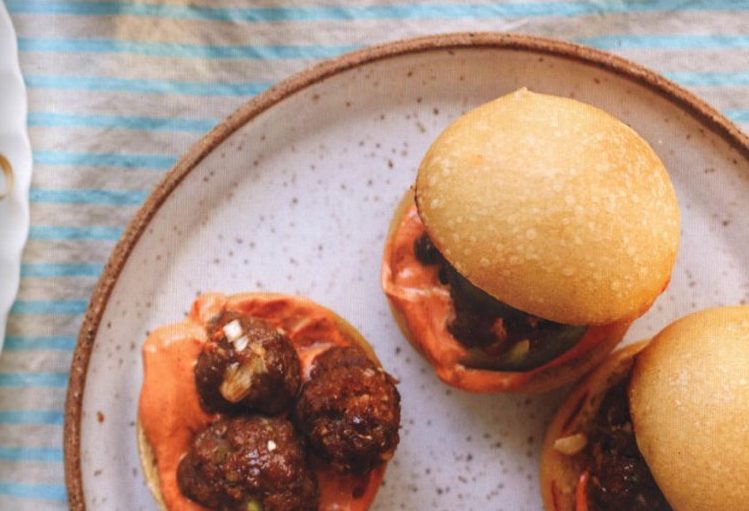“Everyday Korean,” By Kim Sunée and Seung Hee Lee. Countryman Press. $29.95.
As I flipped through the page of “Everyday Korean: Fresh, Modern Recipes for Home Cooks,” my mind kept drifting back to Christmas dinner.
There on the table, alongside the Waldorf salad, lamb meatballs and pork pie, was a large bowl of fall-off-the bone short ribs. The dish, clearly a favorite among my family, was brought by my sister-in-law’s mother, who was visiting from Seoul to meet her newest grandson.
If we had Korean food cooked by Mrs. Yun at every family meal from now on, I’d be a happy camper.
Since that’s not an option, I turned to “Everyday Korean” by Kim Sunée and nutritional scientist Seung Hee Lee for a crash course in the basics. They describe their book, released last year, as “accessible Korean cooking with a modern twist.”
Sunée, who was born in South Korea and adopted around age 3, grew up watching her adoptive American grandfather stir pots of crawfish bisque and red beans and rice.
“As much as I was fascinated by Korean cuisine, I was also intimidated by the idea of actually cooking with techniques and ingredients so different from my culinary background,” Sunée wrote in the preface.

Seung Hee Lee grew up being cared for by a grandmother “who never left the kitchen” and considered the kitchen her playground. She met Sunée when the American was visiting Korea to search for her birth family. The book they created together features traditional Korean recipes – many from Seung Hee’s own family – with a modern twist.
Split into 10 chapters, the book follows through on the writers’ promise of accessibility. Recipes are grouped by type – “soups and broth” and “pancakes, fritters and small bites,” for example – and are written with clear descriptions and instructions. I find this particularly helpful when learning how to cook an unfamiliar cuisine.
Also helpful is the introduction with a photo guide to common ingredients like jujube and gochujang, the list of other pantry staples and a glossary with descriptions of food and spices often used in Korean cooking.
I was tempted by nearly every recipe I read, including the Green Onion and Seafood Pancakes, Tofu Jerky and Korean-Style Poke. When I got to the Beef Bulgogi Meatballs, I knew it was a recipe my husband, Adam, would be eager to try. Two years ago, when Mrs. Yun was visiting after the birth of my first perfect nephew, she made us beef bulgogi that Adam still talks about.
The recipe is a play on bulgogi, one of Korea’s most popular beef dishes, but with a distinctly American twist. The writers provide instructions for making either meatballs or sliders. We went with the sliders. The beef and veal mixture was easy to pull together with ingredients I already had in my pantry or found at my small local supermarket. The meat was moist and flavorful – perfect for the slider I topped with a bit of mayonnaise and thinly sliced cucumbers. I served leftovers as lettuce wraps with steamed rice.
Maybe next I’ll take inspiration from Mrs. Yun and try the short ribs braised with cinnamon and star anise.
Gillian Graham can be contacted at 791-6315 or at:
ggraham@pressherald.com
Twitter: grahamgillian
BEEF BULGOGI MEATBALLS
Makes 18 slider patties or 40 to 50 meatballs
1/4 cup low-sodium soy sauce
2 teaspoons fish sauce
3 tablespoons dark brown sugar
1/2 Asian pear, or Bosc or Bartlett pear, grated
2 tablespoons minced garlic
3 tablespoons minced green onion
3/4 teaspoon freshly ground black pepper
2 tablespoons toasted sesame oil
1 large egg, lightly beaten
1/3 cup homemade dried bread crumbs or panko
1 pound ground beef, preferably chuck or short rib
1 pound ground pork or veal
Neutral oil, such as canola or grapeseed, for pan frying (optional)
8 small slider buns or lettuce leaves and steamed rice
Combine the soy sauce, fish sauce, brown sugar, pear, garlic, green onion, black pepper and sesame oil in a large bowl; whisk well. Add the egg, bread crumbs and ground meats and mix just to combine all the ingredients, being careful not to over mix. Cover and let chill in the refrigerator for 30 minutes and up to 2 hours.
Preheat the oven to 425 degrees. Form the meat mixture into about 18 slider patties or 40 to 50 mini meatballs and place on a baking sheet. Bake the patties or meatballs until golden and cooked through but still tender and moist, 18 to 20 minutes, turning the pan halfway through cooking time to ensure even cooking. Alternatively, heat about 1 tablespoon neutral oil in a large pan over medium-high heat. Add the patties or meatballs, being careful not to crowd the pan. Cook, shaking the pan occasionally, until the meat starts to brown on one side, about 3 minutes. Gently turn and cook another 3 to 4 minutes, or until the meatballs are just cooked through and still tender.
If making sliders and adding cheese, top the patties with cheese about 2 minutes before the cooking time is over. Toast the slider buns and top with the patties and extra pan sauce and your favorite toppings. Meatballs can be served with lettuce leaves and rice, or on top of rice bowls. Optional toppings for sliders: cheddar, mayonnaise or mustard.
Send questions/comments to the editors.




Comments are no longer available on this story